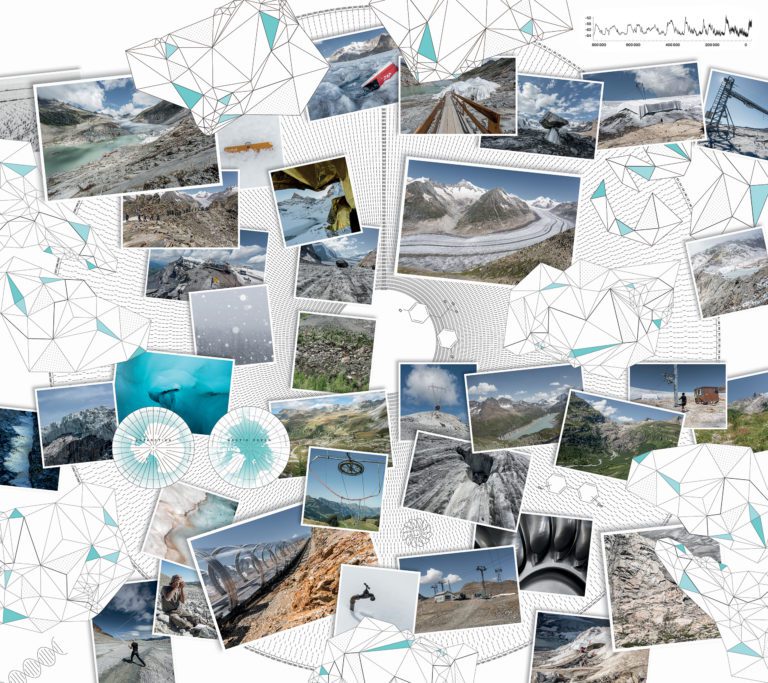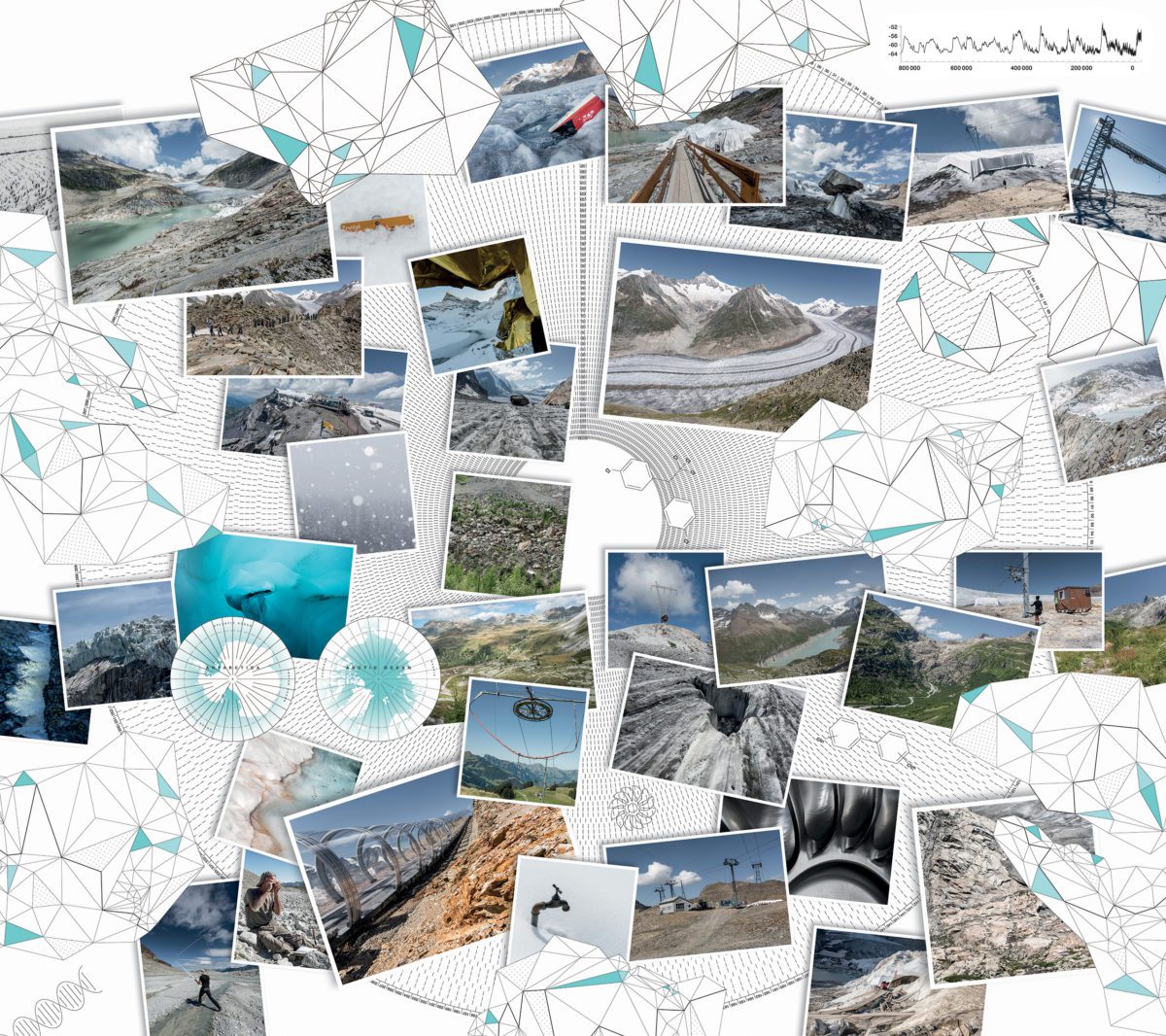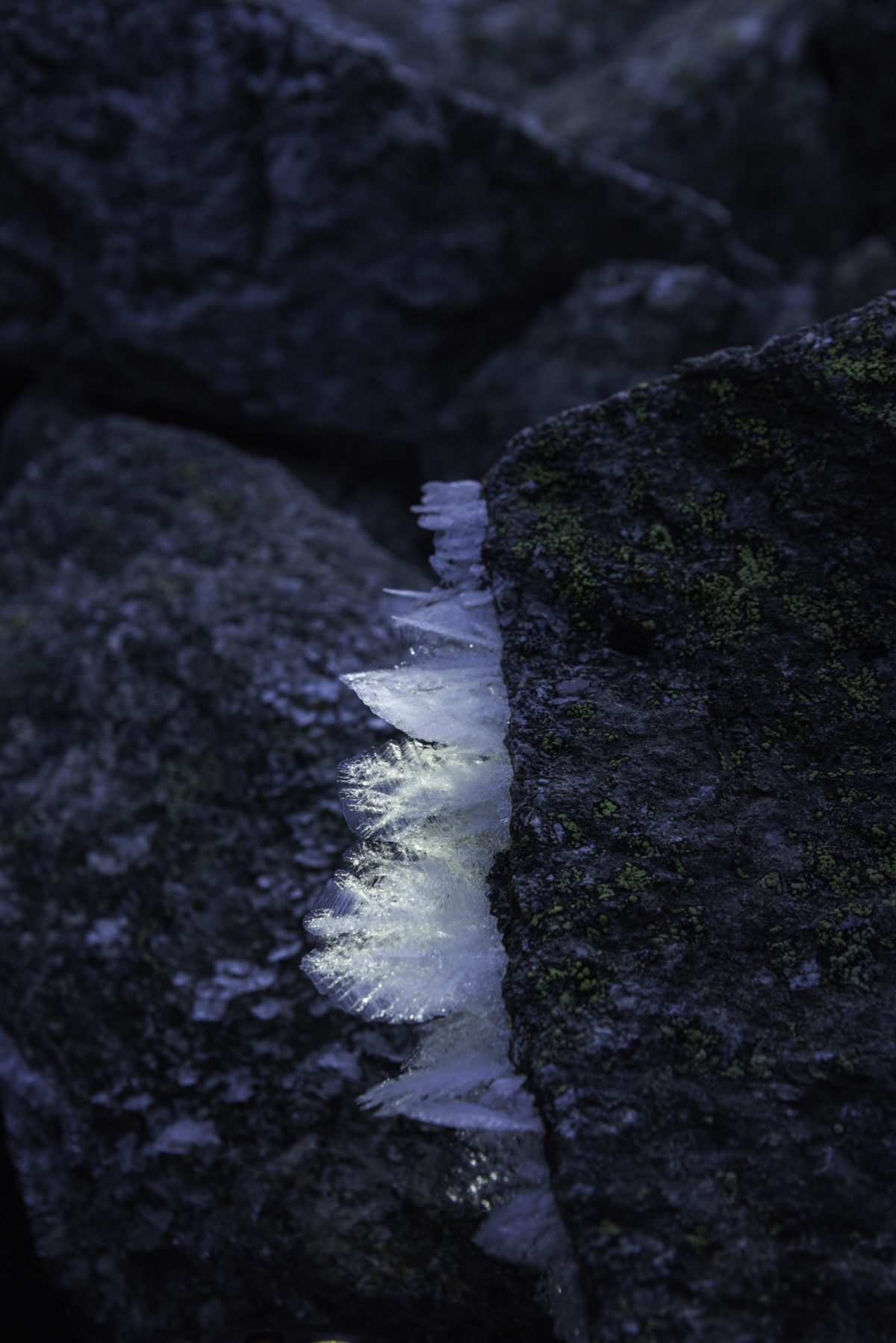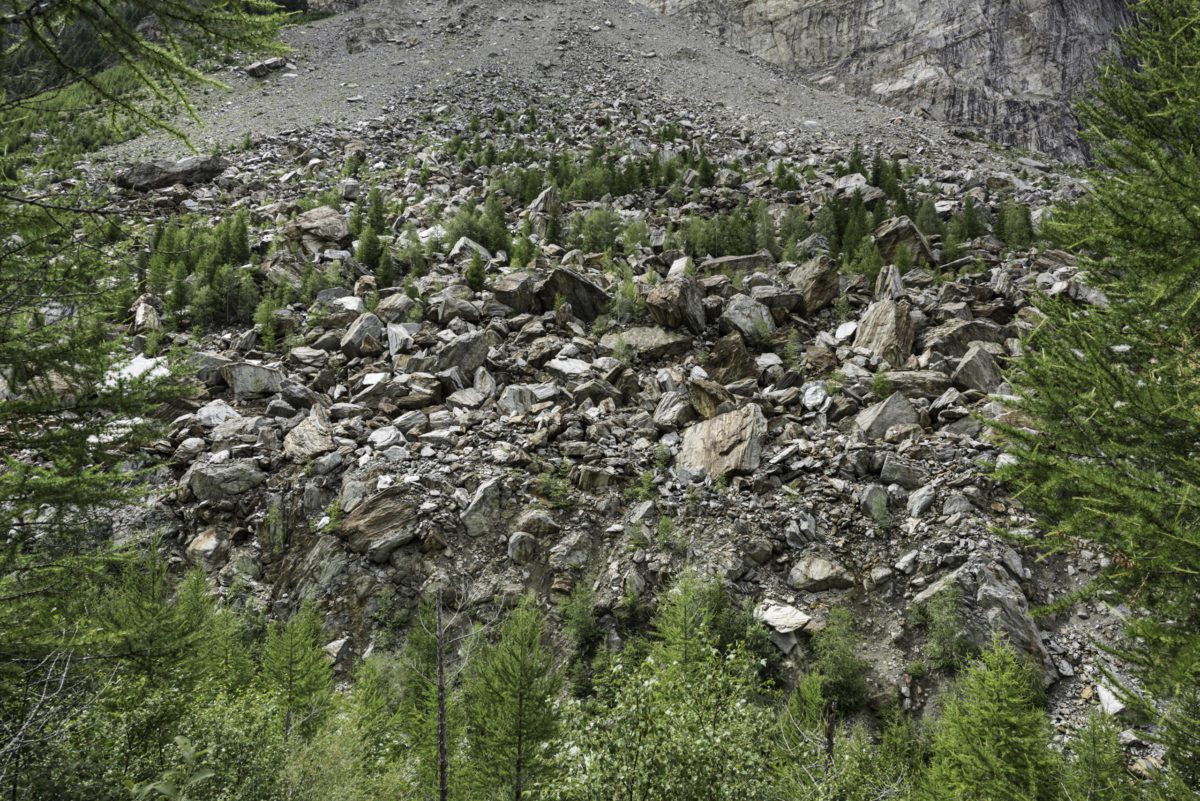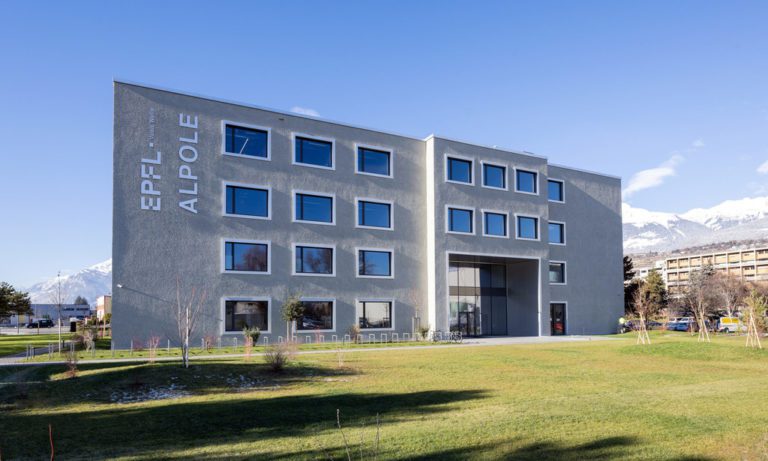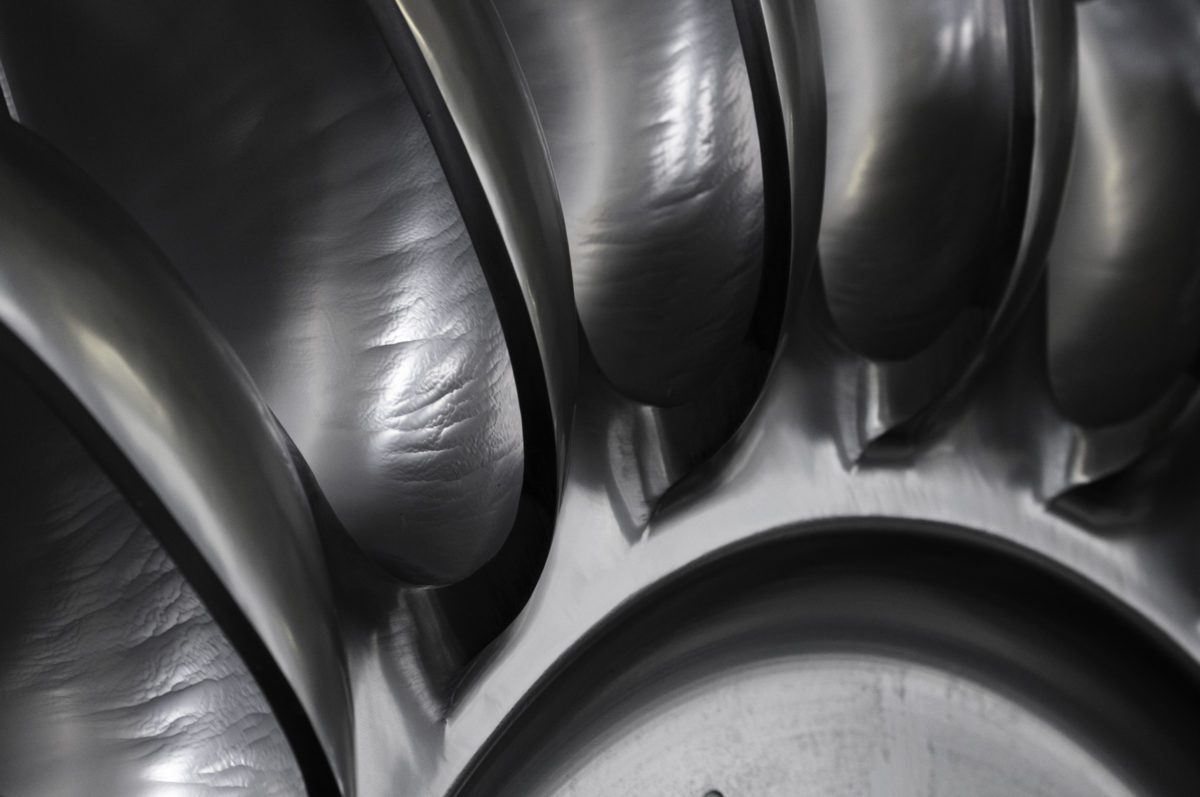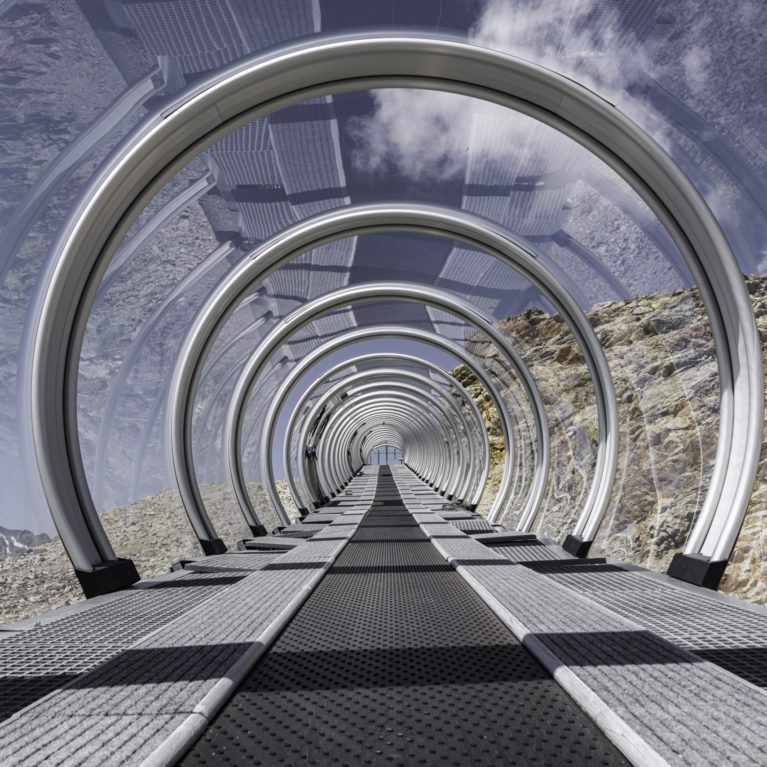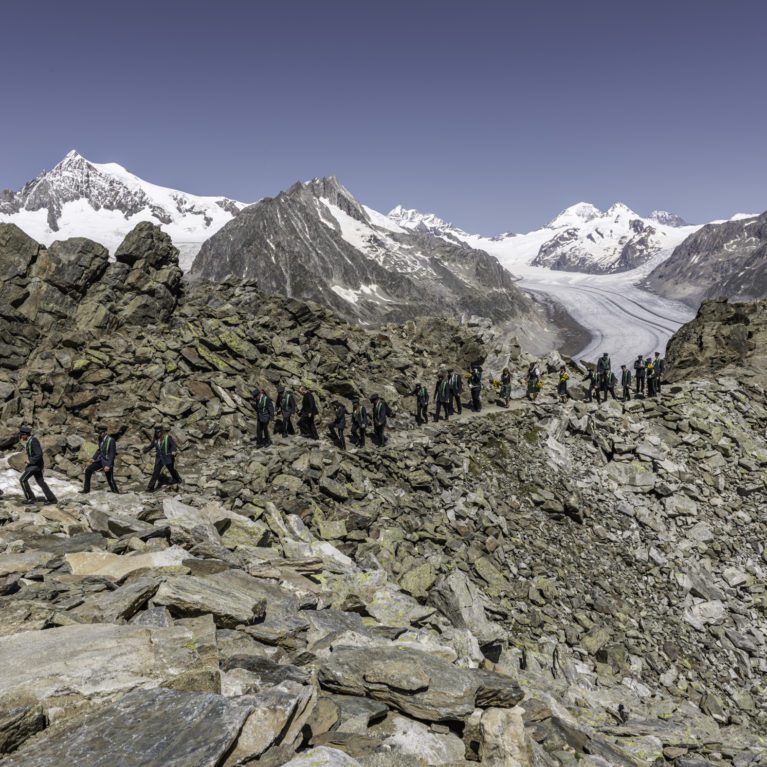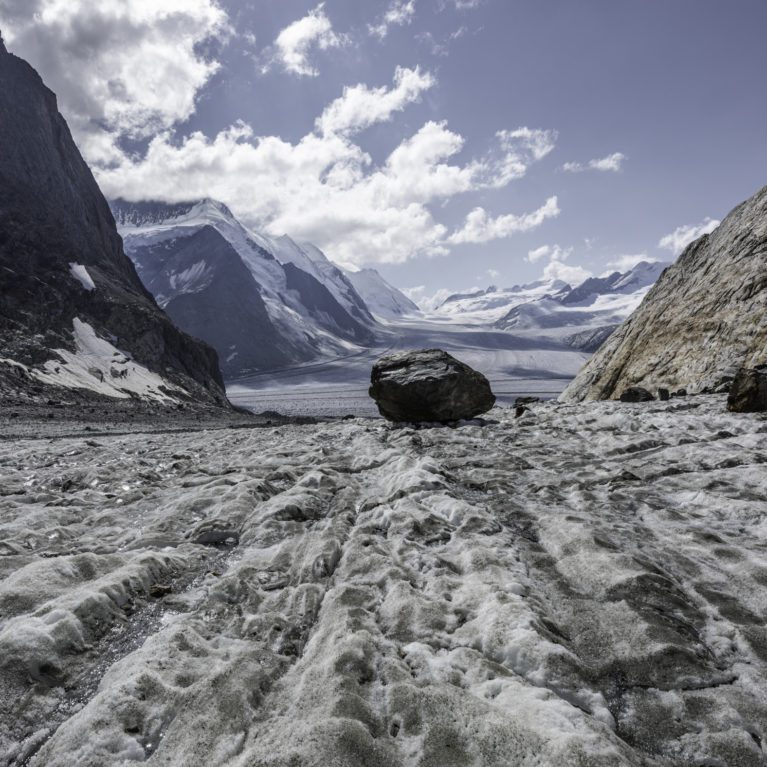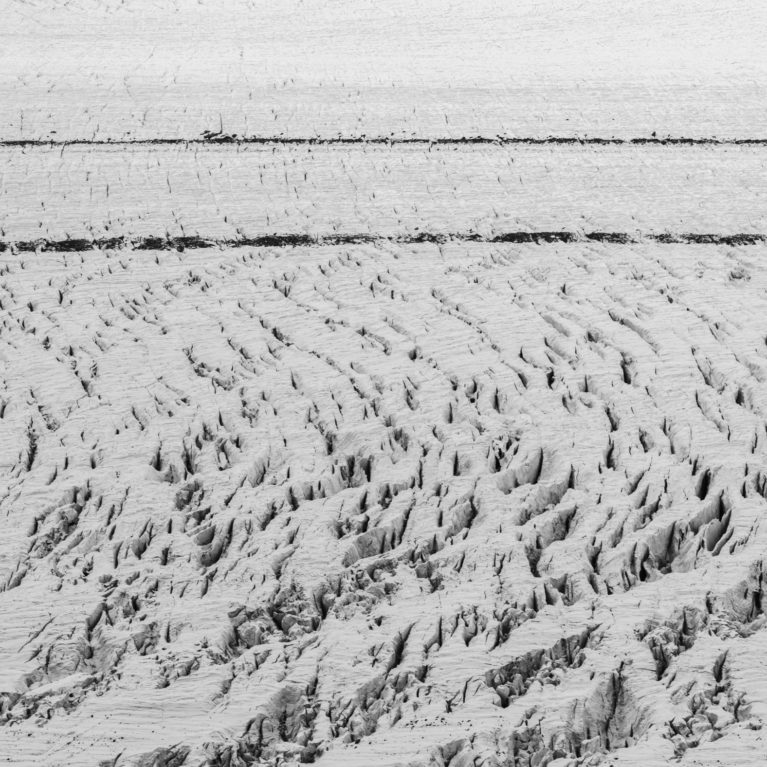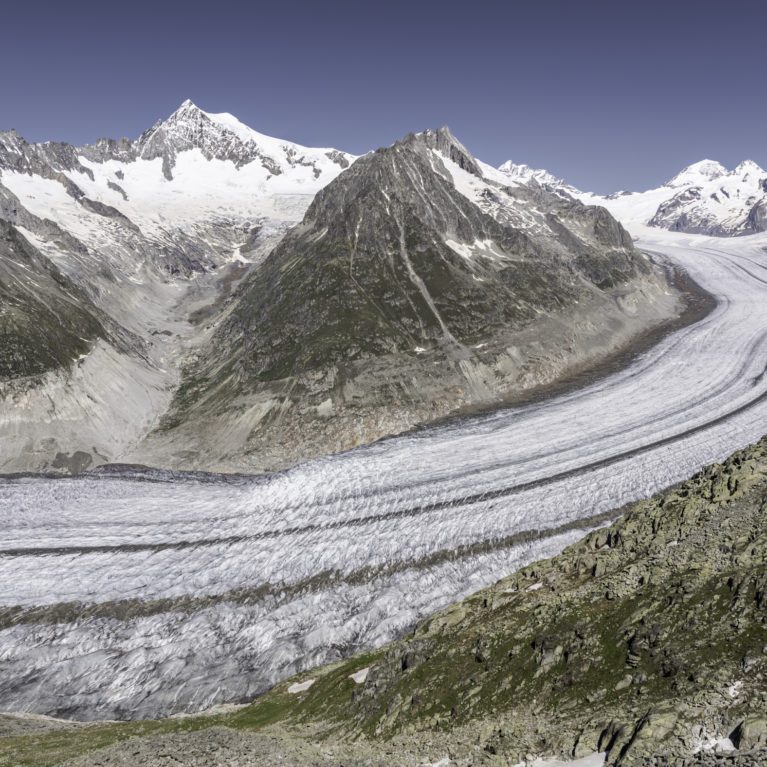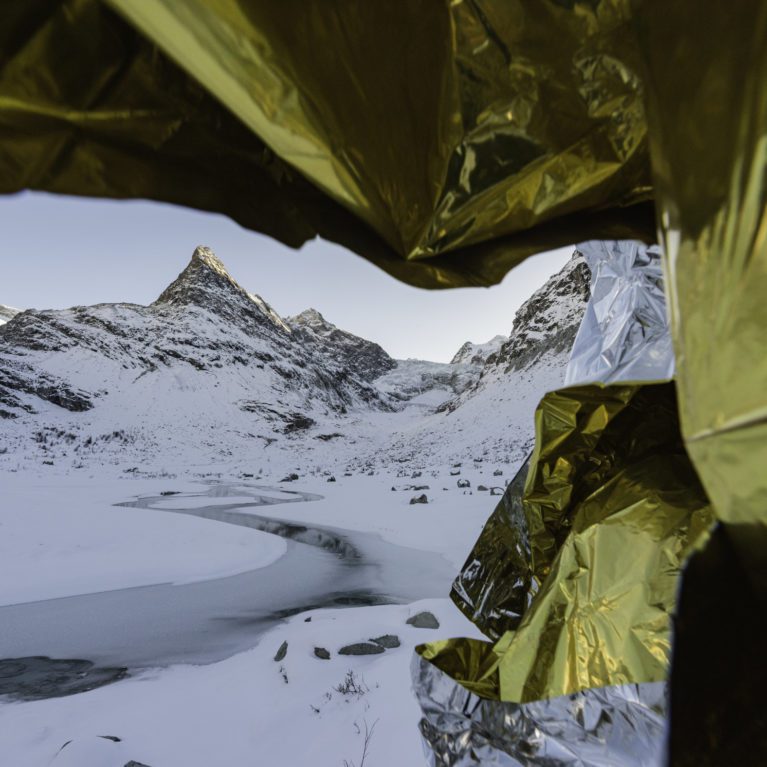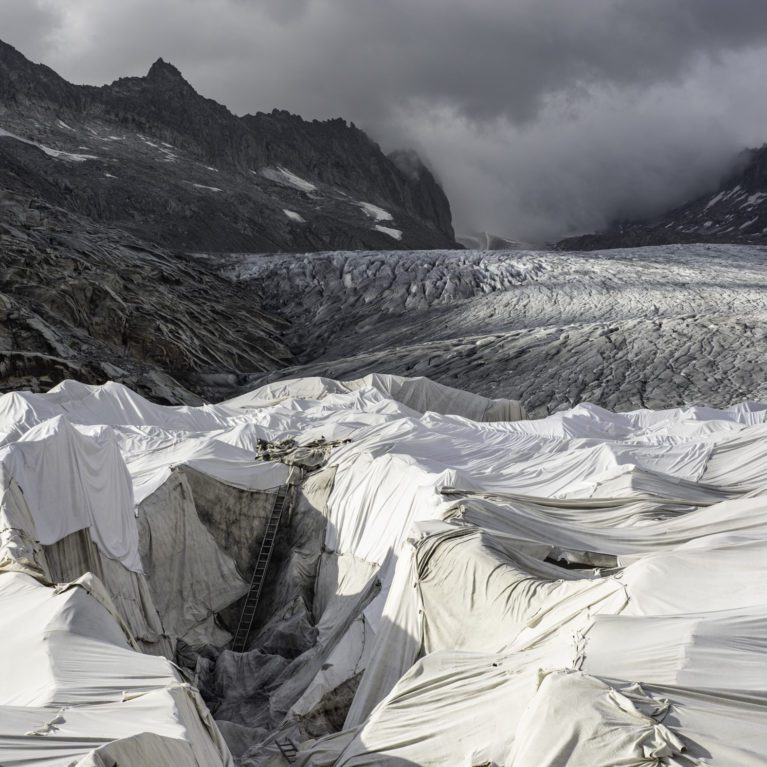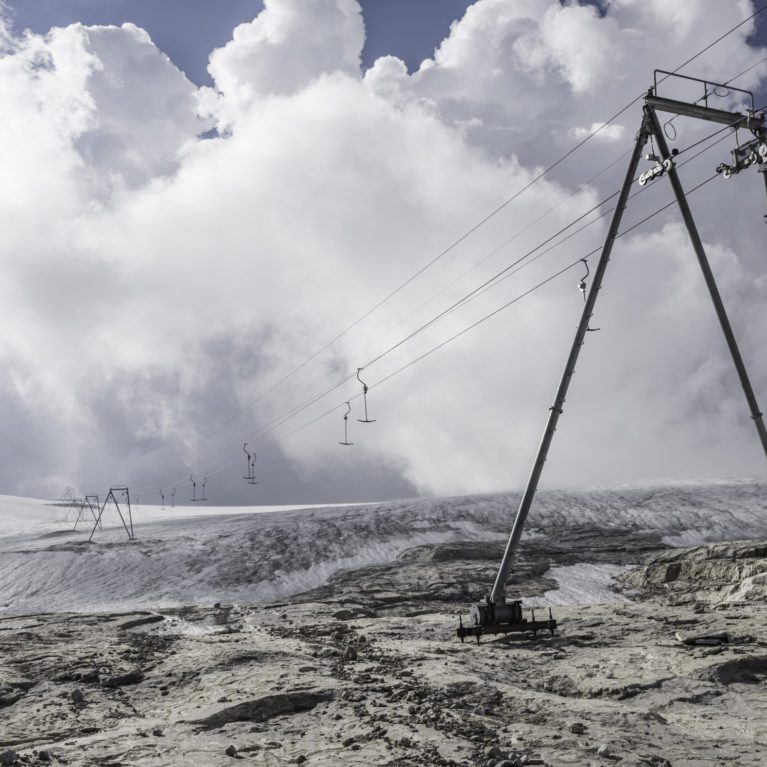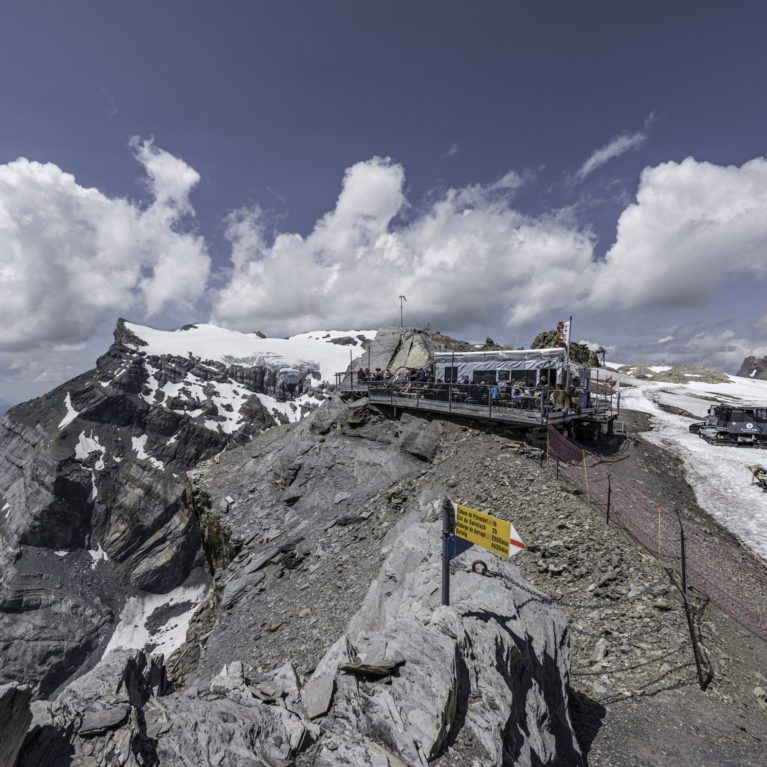1.3 kilometers
That’s how far the Rhône Glacier in Switzerland’s Haut-Valais region has receded in just over a century. This summer was undoubtedly the last in which tourists could walk through the glacier’s famous ice grotto. The blue arches are melting relentlessly, despite the geotextile tarps laid over hundreds of square meters of the glacier to shield it from the sun.
It’s a rude awakening. We’ve always seen the Swiss landscape as eternally draped in white – but now this icy mantle appears to be on the path to extinction. And even though scientists have been sounding the alarm bell for decades, the prospect of a glacier-free, snow-free Switzerland is still a shock. Yet this is the reality shaping up before us on a human timescale, as new global warming records are set year after year. There was the record-hot summer last year that caused 6% of Switzerland’s glacier mass (equivalent to 3 km3 of ice) to melt away, whereas in previous years a 2% loss was considered “extreme.” And there was the record-high freezing level recorded this summer, at an altitude of 5,298 meters (in the mountains above Broye) – something not seen since measurements began 150 years ago.
Yet the Alps’ melting glaciers, while highly visible, are only the tip of the iceberg, if you consider climate change on a global scale. Experts currently estimate that every kilogram of CO₂ emitted into the air causes 15 kilograms of ice to melt. The polar ice caps in particular – which serve as the Earth’s air conditioning – are disappearing at an astounding rate (see below). Research teams who traveled to the Antarctic this spring could only shake their heads: 136,000 km² of glacier surface had been lost in 12 months. That’s more than three times the surface area of Switzerland. The region is warming twice as fast as climate models had predicted owing to a vicious circle underway: with less ice, the ocean surface is less protected by the albedo effect (whereby the sun’s rays are reflected away by snow cover), causing the water to reach higher temperatures, thus preventing the formation of new ice, and so on.
- Polar ice holds the key to our future on Earth
- Permafrost: a ticking time bomb beneath our feet
- Vanishing worlds: Exploring our planet’s icy ecosystems
- Reading ice cores like pages of a history book
- Water set to become an increasingly liquid asset
- “Valais is an ideal laboratory to study climate change impacts.”
- Possible future
Devastating consequences
Scientists are trying to alert people to the threats arising from the incredibly fast pace of glacier melting. Sea levels could climb by several meters, which would be devastating for communities living close to the ocean. And the large amounts of cold fresh water pouring into ocean currents could seriously disrupt global weather systems.
Some countries won’t be affected directly by the rising sea levels – but if they have glaciers, they’ll be impacted by glacier retreat. Increasingly severe heat waves and droughts will cause their glaciers to melt rapidly, initially triggering floods and landslides before the glacier-fed streams eventually dry up. This is especially worrying in Switzerland, where half of the country’s electricity is generated by hydropower dams. Not to mention the effects on the country’s travel industry – a major component of its economy.
There’s no doubt about it – we must act now to mitigate the increasingly severe consequences of climate change. It’s hard to grasp the full gravity of the situation: even if we were to stop all carbon emissions today, Alpine glaciers would keep melting for a long time to come since the current climate is already too warm. Only a steep 2°–3°C drop in average global temperatures would let them regain ice mass.
That said, there’s still hope. If we manage to cut carbon emissions by a factor of seven between now and 2030, global warming will level off at 1.5°C above pre-industrial levels. That’s the target set in the Paris Agreement. And that would let us preserve one third of the surface area of the Earth’s largest glaciers. That’s not much for the icy titans that have inhabited our mountaintops for 12,000 years. But it’s the only choice we have if we don’t want Alpine postcards to lose their snowy peaks.
10 %
Ten percent. That’s the amount of volume lost by Swiss glaciers in the past two yearsdue to a record lack of snow and very hot summers.
In total, our glaciers have lost 2.2 cubic kilometers of ice, approximately twice the size of Lake Biel. What’s even more striking is that it took our glaciers 30 years to retreat by the same amount between 1960 and 1990. Scientific models predict continued rapid melting in the coming decades unless climate measures are adopted.
The snow- and ice-covered polar regions might seem like a world away, but they play a crucial role in maintaining global climate stability. Billions of people and animals depend on the frozen parts of our planet for survival. But as the ice melts and sea levels rise, our shared future on Earth is under threat. If the Greenland ice sheet were to melt completely, the global sea level would rise by 6 meters. The loss of all Antarctic ice would cause the oceans to swell by a further 60 meters, fundamentally altering the map of the world as we know it.
Of course, these processes would occur over hundreds or even thousands of years. But one thing is for certain: the cryosphere – which encompasses all of the Earth’s glaciers, ice shelves, polar ice caps and permafrost – is receding, and the pace of this melting is accelerating. This trend is all too clear in satellite images of polar sea ice dating back to 1979, which reveal that the Arctic ice field has shrunk by almost 50% in the space of four decades. And there’s been no letup in this trend in 2023.
“This year, the sea ice minimum, which happens in September, was at its fifth-lowest level ever recorded,” says Julia Schmale, who heads EPFL’s Extreme Environments Research Laboratory – Ingvar Kamprad Chair. “Sea-ice cover varies naturally from year to year, but it’s highly likely that by the middle of the century, the Arctic will be completely ice-free at this time of year.”
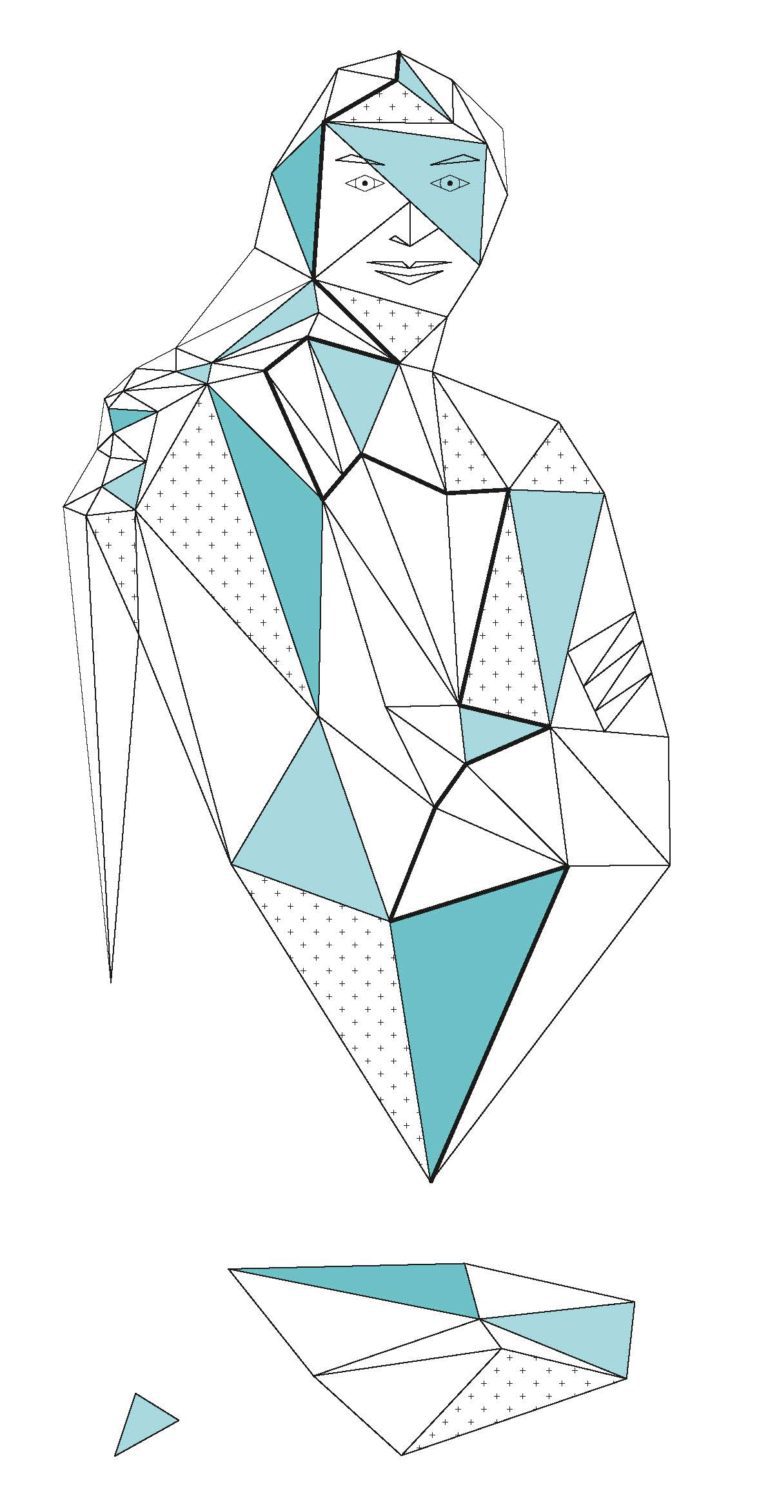
Julia Schmale. © Illustration by Laurence Piaget-Dubuis
Maintaining climate stability
Things on the other side of the planet are even more worrying. After decades of records showing that the extent of Antarctic sea ice had been increasing year after year, the trend now seems to be reversing: significant retreat was recorded in the past two years, and in 2023, the mid-September sea-ice maximum was the lowest on record. “The extent of sea ice at both poles has been unusually low this year,” says Schmale. “The changes in the Arctic are clearly the result of global warming. But in the Antarctic, the dynamics are more counterintuitive, so further research is needed to get a clear picture of what’s going on. In any case, there’s real cause for concern!”
Why is it so important to protect our cryosphere? “First of all, because of the laws of physics,” says Schmale. “Ice and snow reflect the sun’s rays back into space, whereas dark-colored ground absorbs the rays and heats up. This is what’s called the albedo effect. As the ice melts, more heat will be absorbed, which in turn will speed up climate change.”
The vast majority of the world’s freshwater reserves are locked away in land ice (the Antarctic ice sheet alone holds 70% of all fresh water on Earth). Communities across the globe depend on snow that accumulates in the mountains during the winter and provides a source of fresh water in the summer. The cryosphere also hosts precious ecosystems that help maintain a natural ecological balance. Aside from iconic species such as the Arctic polar bear and the Antarctic penguin, the polar regions are home to specially adapted microbes. The loss of these species could lead to a collapse of the food chain.
Not all ice is made equal
The effects of polar melting are also being felt at lower latitudes. “The Arctic is heating four times as fast as the global average, and the Antarctic twice as fast,” explains Schmale. “The temperature gradient between the poles and the mid-latitudes is decreasing. This gradient affects the movement of air masses and, in turn, the volume, frequency and location of precipitation. So what happens at the poles influences the weather elsewhere on the planet, including in Europe.” Schmale also notes that the loss of polar ice is affecting indigenous Arctic communities, who face fundamental threats to their traditional lifestyles and practices.
To the uninitiated, all ice may look the same. But to scientists, ice is not a uniform medium – which makes studying it a complex endeavor. Sea ice, for instance, expands and contracts as the seasons change, reaching a maximum during the cold winter nights before retreating during the months when the sun never sets. “Think of it like the ice shelf breathing in and out over the course of a year,” says Schmale. At both poles, the frozen seawater is naturally saline and serves as a habitat for numerous microorganisms, meaning it plays a vital role in the food chain.
Land ice, meanwhile, operates under a different set of rules. Glaciers and ice caps are freshwater bodies formed by the accumulation of snow. They move like slow rivers, as the weight of the ice on top pushes the layers underneath outward toward the edges and downward toward the tongue. And they’re formed over long periods of time: the ice is old and thick – up to 3 km in Greenland and 4 km in Antarctica. As temperatures rise, the ice at the summit tends to melt first, creating rivers of water below that accelerate glacier retreat.
What happens at the poles influences the weather elsewhere on the planet, including in Europe.”
The importance of snow
“We can’t understand the processes at work in the cryosphere without studying snow,” says Michael Lehning, head of EPFL’s Laboratory of Cryospheric Sciences. Snow is the main driver of the albedo effect, and the way snow interacts with other components – ice, water, wind, temperature and land – can have major implications. “Bodies of pure ice, like a frozen lake, tend to be quite dark in color,” explains Lehning. “They absorb solar radiation, eventually causing the ice to melt. But when a thin layer of snow accumulates on the ice, the solar radiation is reflected. That means the surface stays cold, allowing the ice to thicken.”
Snow thickness is another important factor: its weight can force part of an ice floe downward, allowing water to seep in through the sides and soak the snow, which then re-freezes. This process plays a key role in sea-ice formation in the Antarctic. If the underlying layer of ice is thin, however, the snow acts like an insulating blanket, preventing the sea ice from thickening. This is what tends to happen in the Arctic.
In short, the various mechanisms taking place are incredibly complex. “Snow is the key to understanding all these processes,” says Lehning. “But existing studies and models often overlook it as a crucial factor.” While gaining further insight into these phenomena is essential, we also need to act on what we learn. Both Schmale and Lehning agree that unless we drastically reduce global CO₂ emissions, there’s no way we could realistically protect the cryosphere and mitigate the effects of climate change.
Snow is the key to understanding all these processes”

Mapping the blue ice in Antarctica from the sky
Antarctica’s blue ice is a gold mine of information for scientists. Yet it’s scattered across areas making up just 1% of the continent’s surface – so it’s not easy to find. But now, researchers have generated a map of blue ice areas by combining artificial intelligence with satellite data.
To the uninitiated, the Antarctic can appear chillingly monochromatic with its 14 million km2 of white ice. Yet look a little closer and you’ll see patches of light blue here and there, forming a striking contrast and offering unique photo opportunities for those brave enough to visit. Beyond their natural beauty, however, these blue ice areas (BIAs) are indicators of a hidden treasure: meteorites.
Blue ice is usually buried under hundreds of meters of white ice, but can appear at the surface if the white ice is eroded through abrasion, exposing the deeper layers of ice located near the underlying bedrock. Blue ice was formed through processes that in some places date back over two million years, meaning it’s ages old. Glaciologists in particular seek out BIAs because they provide an opportunity to sample old ice without the need for core drilling and to collect data on meteorites – providing key information on outer space – as well as on hard-to-reach terrestrial rocks. “Around two thirds of the meteorites retrieved on Earth come from Antarctic BIAs,” says Veronica Tollenaar, a guest researcher at EPFL’s Environmental Computational Science and Earth Observation Laboratory (ECEO) and a PhD student at the Université Libre de Bruxelles. Given how valuable BIAs are for scientists, and the fact that they account for barely 1% of the vast Antarctic surface, it’s easy to see how a map indicating precisely where they are could save researchers precious time.
Deep-learning model trained on satellite data
Tollenaar set out to create such a map by developing a deep-learning model and then training it on data from several satellites so that it could accurately recognize BIAs. She explains that the observations used were radar backscatter, surface morphology and elevation, as well as multispectral reflectance – a technique used to isolate individual wavelengths. Because Tollenaar’s model incorporates these different kinds of data, it isn’t subject to the biases that impaired previous efforts to map Antarctic BIAs; these biases result from temporary snow coverage and sensor-dependent conditions such as solar illumination angles and cloud cover. The existing BIA dataset used to train the model contained quite a bit of “noise” on the exact boundary of each area. But the model was eventually able to eliminate the majority of that noise, and its performance was further enhanced with a reduced set of “noise-free,” hand-labeled validation data.
“We’ve already gotten a lot of interest in the map from the various research groups here at EPFL that are studying snow and ice as well as meteorites,” says Devis Tuia, the head of ECEO.
Cécilia Carron
Permafrost is a layer of soil, rock or sediment that remains at a temperature of 0°C or below all year round. While it gets little public attention, permafrost nevertheless covers 22% of the Earth’s land surface. It’s mostly found at northern latitudes – in Greenland, Canada, Alaska and Russia – and at altitudes above the tree line. Around 5%–6% of Switzerland is covered by permafrost. We asked Michael Lehning, head of EPFL’s Laboratory of Cryospheric Sciences, for his insights on what the thawing permafrost means for our climate.
What are the main risks associated with thawing permafrost?
The main concern is that, in polar regions, permafrost holds vast stores of CO₂ and methane – two powerful greenhouse gases. If these gases were to be released, the implications for the climate would be catastrophic. But that’s not all: polar permafrost also contains bacteria and microbes that have been frozen for thousands of years and that could potentially reawaken, as well as large quantities of mercury – although the jury is still out on the exact concentrations and the potential impact.
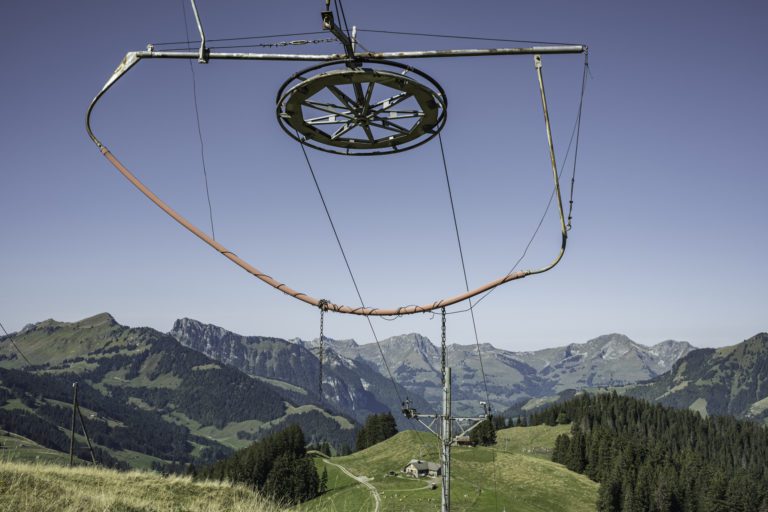
Château d’Oex. © Laurence Piaget-Dubuis
How much CO₂ and methane could be released?
Polar permafrost consists primarily of marshlands and peat bogs, where the moisture content is high and plant matter decomposes very slowly due to the cold temperatures. This creates the perfect anaerobic conditions for carbon storage. Permafrost is estimated to contain twice as much CO₂ and methane as is currently in the atmosphere. If this large store were to be released, that would significantly speed up global warming. That said, we don’t yet fully understand the dynamics at play, especially when it comes to natural compensation mechanisms. For instance, we know that some of the additional CO₂ would be fixed by new plant growth – but we don’t know how much. As things currently stand, we believe that permafrost melt will generally amplify the effects of climate change.
Is it true that permafrost is thawing faster than expected?
Yes. Early climate models predicted that we wouldn’t reach the current stage of permafrost melt until 2090! That shows just how hard it is to forecast permafrost dynamics. The margin of uncertainty is much larger than for glaciers, whose changes are more visible. Studying permafrost is really complicated – not just because everything happens deep beneath our feet, but also because of the sheer extent of the Earth’s surface it covers. A sample taken in one location tells us nothing about the composition and dynamics of permafrost as a whole.
Studying permafrost is really complicated – not just because everything happens deep beneath our feet, but also because of the sheer extent of the Earth’s surface it covers”
What threat does this thawing pose to Alpine regions?
When high-altitude permafrost thaws, it can cause the land to become unstable. This is something scientists are monitoring closely in Switzerland. There’s a risk to structures such as buildings, pipelines, dams, cable-car stations and power substations, for example. The good news is that we’d be warned of potential disasters in advance because we’d see signs of cracks forming, for instance. The possibility of catastrophic landslides can’t be completely ruled out, but these kinds of events aren’t usually triggered by high-altitude permafrost melt, since only the surface layer is permanently frozen in these regions. The biggest threat comes from land instability coupled with more intense precipitation, as that could lead to more landslides and rock falls, as well as more sediment making its way downstream and silting up river beds. It’s a problem that would play out more gradually, but the damage could still be significant.
It all begins with a speck. Brought in by the wind, dust, soot, or other particulate matter deposits on the ice. The newly arrived nutrients awaken microorganisms – bacteria, algae or fungi – that lie dormant on the surface. As their metabolisms produce organic matter, the speck grows, absorbing more sunlight and burrowing deeper into the melting ice. The dimples formed fill with nutrient-rich meltwater, fueling further growth. The result is an ecosystem-in-a-puddle, or cryoconite – a fascinating demonstration of glacier landscapes shaping and being shaped by their microscopic inhabitants.
Ice covers one tenth of our planet’s surface. Still, says Tom Battin, who leads EPFL’s River Ecosystems Laboratory, we’ve only just begun to catalog the myriad species these frozen habitats are home to. “Glaciers are our water towers, and the streams they feed are the taps that deliver fresh water to hundreds of millions of people. But they are more than just that, and it’s time we understand what else we will lose when the ice melts. What species live up there, and what biodiversity is at risk? For that, we need to conduct a thorough census of the local biodiversity.”
Teeming with life, above, within, and below the ice
Until a few decades ago, glaciers were often absent in ecology textbooks. Today, we know they are teeming with microbial life. At their surface, bacteria, algae, and fungi take full advantage of the short growing season. Sometimes visible to the naked eye as cryoconites or red-colored snow, they mobilize a rich repertoire of tools to harvest solar energy. Down below, the glaciers’ relentless flow crushes the underlying bedrock in “mineral factories” replete with nutrients that serve as a source of energy for specialized bacteria. And within the ice, often several kilometers deep, microbes form pockets of life within three-dimensional networks filled with circulating liquid brine.
For just over two decades, Battin has been studying these microbial glacier ecosystems. He recently led the first systematic global census of microbial diversity in glacier-fed streams that took him and a network of researchers to all four corners of the globe. “With support from the Nomis Foundation, we were able to sample glaciers in the Americas, Europe, Asia, New Zealand and Africa. By combining cutting-edge molecular biology methods with phylogeny, we assembled a unique dataset that lets us identify global patterns and, for the first time, get a comprehensive view of these threatened ecosystems. It’s a game changer,” he says.
By studying the microorganisms that make up glacier ecosystems, researchers hope to better understand the strategies they have evolved to scavenge energy in some of the planet’s harshest environments, overcoming sub-zero temperatures, scarce organic nutrients, ultraviolet radiation and frequent freeze-thaw cycles. “The species we find in glaciers often have a very plastic metabolism that lets them switch from sunlight-harvesting photoautotrophs to organic carbon-consuming heterotrophs. The chemolithoautotrophs, meanwhile, survive by drawing energy from inorganic compounds.”

Illustration by Laurence Piaget-Dubuis
Ecosystems at risk: Implications of melting ice
By transforming inorganic compounds – carbon, nitrogen and sulfur – into more readily available organic ones, these microorganisms provide vital nutrients for food webs of growing complexity further downstream. Just how much is at stake as their habitats disappear is not yet fully understood. But, says Battin, “the bottom line is that as glaciers melt, this vast biodiversity is being homogenized as specialized microbes, algae and invertebrates they harbor are replaced by generalists that can move upstream and colonize these newly ice-free habitats.”
Their disappearance also comes with a loss of hitherto unrecognized genetic potential that could benefit humanity. “Biotechnology firms are interested in bioprospecting these bacteria, for example, for enzymes capable of catalyzing chemical processes at low temperatures. These could increase the energy efficiency of industrial processes by lowering the required processing temperatures. Similarly, pharmaceutical companies hope to find new antibiotics in these remote and pristine environments.”
Ice is not just frozen water, but also home to a complex biome.”
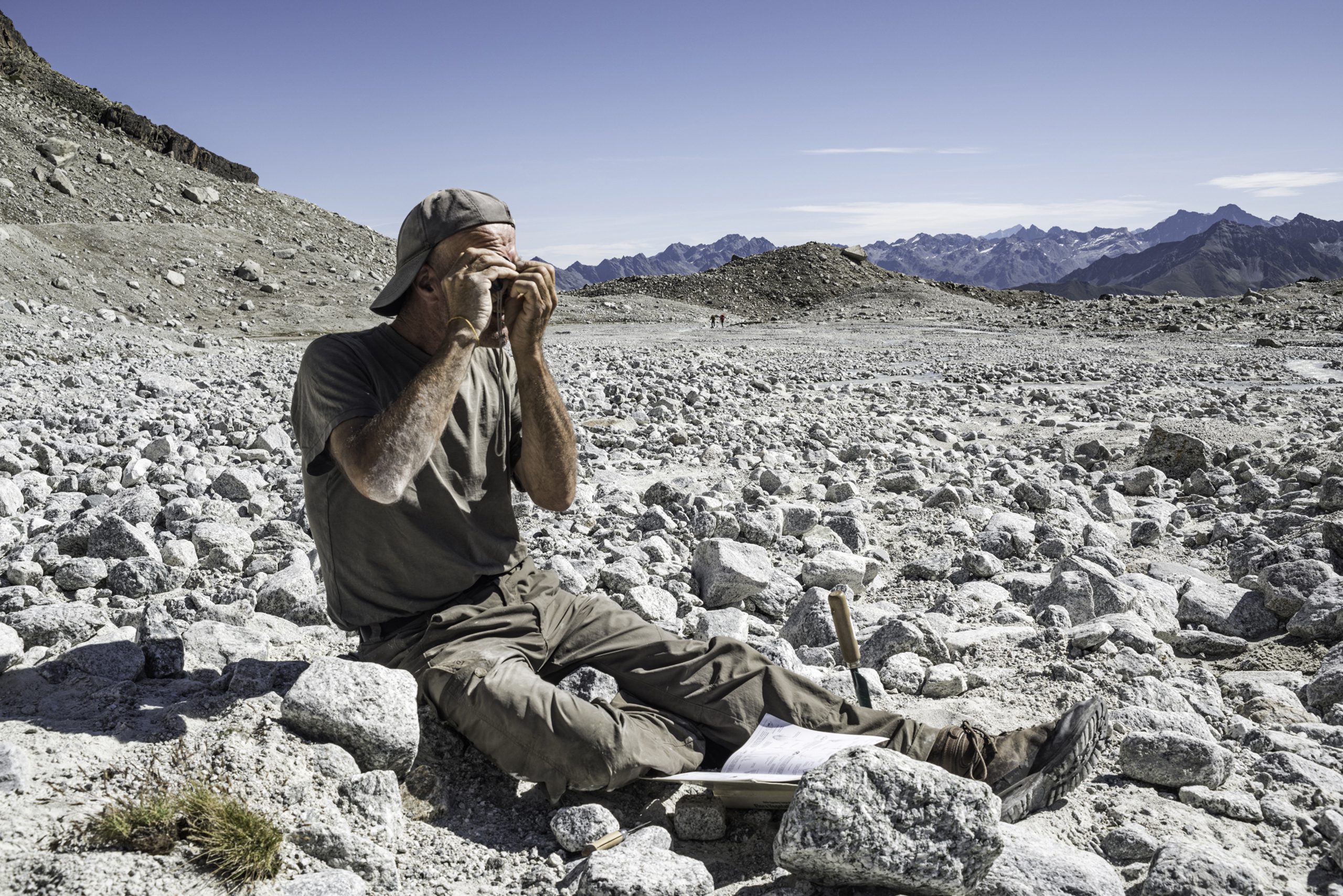
Overcoming challenges on Earth and beyond
That’s one reason why ongoing initiatives seek to preserve these microorganisms in biobanks, says Ianina Altshuler, who studies permafrost ecosystems. The task is challenging: “We are only able to culture and preserve a small percentage of microbial species, around one to two percent” she says. Taking stock of active microorganisms in their cryospheric niches is no less complicated. “It’s a big challenge to identify the organisms that are active in these ecosystems, for example, within brine veins in the permafrost, because there are so few of them relative to the organisms that are dead or dormant in the substrate surrounding them.”
The experience gained studying these microbial ecosystems in their harsh habitats could one day prove valuable to research carried out much, much farther afield. “Cryospheric environments on Earth are analogue sites that we can use to test devices that could be payloads on missions searching for life on Mars or Enceladus, Saturn’s icy ocean moon,” says Altshuler. Working with a team of researchers, she participated in developing a semiautomated life-detection system capable of collecting and processing environmental samples and detecting the fingerprints of biological life. Designed such that it can be incorporated into a moon rover, the instrument demonstrated its capabilities in the Canadian high Arctic.
Training the next generation of cryosphere scientists
In the meantime, the researchers will continue to study icy ecosystems right here on Earth. “The goal of the ongoing ICEBIO project, carried out with partners in Denmark, Germany, France, Austria and the UK, is to train a generation of young scientists that is aware that ice is not just frozen water, but also home to a complex biome. By studying small-scale feedback loops and investigating their big-picture implications, participants will try to predict how these ecosystems could change as warming continues,” says Battin, who is supervising two PhD students funded by the ICEBIO Marie Skłodowska-Curie Doctoral Network.
Their work has involved fieldwork in Tajikistan as part the Swiss Polar Institute’s PAMIR Tajikistan expedition and, closer to home, coring ice from five glaciers in the canton of Valais and sampling the streams they feed to compare the species detected. It’s a tedious process, alternating between days of field measurements followed by months of downstream work, extracting and sequencing DNA, and analyzing the data using bioinformatic tools. Meanwhile, a second project focuses on exploring stream habitats to better understand golden algae, a “forest-forming” unicellular organism whose unique biophysics makes it particularly adapted to the turbulent flows it thrives in and that is heavily colonized by bacteria.
A clearer picture of the microbiological processes that unfold in the cryosphere could offer insights into the greening of post-glacial ecosystems increasingly observed by ecologists. As glaciers shrink, they mobilize less minerals, allowing a greater fraction of incoming sunlight to shine through the less turbid water, making the riverbed a more hospitable environment for primary producers, effectively establishing “green oases” as photosynthesizing photoautotrophs replace mineral-mining chemolithoautotrophs. It’s a rare transition from a grey to green ecosystem that environmental researchers are reluctant to applaud.
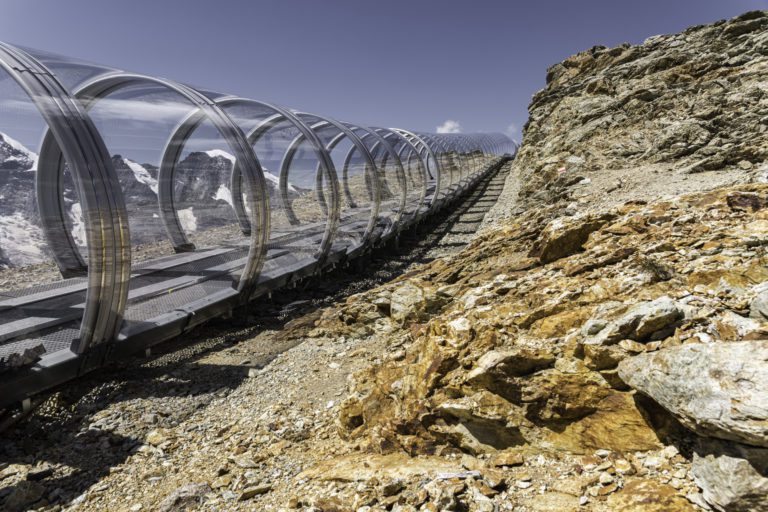
Glacier Diavolezza. © Laurence Piaget-Dubuis
Reading coffee grounds is probably not a reliable method for predicting the future. Ice, on the other hand, is a treasure trove of information, and reading it – like a history book – can tell us much about the Earth’s past. Paleoclimatologists, the scientists who specialize in this field, use the clues contained in ice cores – as well as in ocean and lake sediments, tree rings, limestone deposits and corals – to deduce what our planet looked like at different times in its history. Since ice cores were first drilled in the 1950s and 1960s, they’ve revolutionized our understanding of the climate.
Ice cores are vertical columns of ice measuring around 10 cm in diameter and drilled from a glacier or polar ice cap. The cores are extracted using an electromechanical or thermal drill, depending on the ice properties and desired depth. Glacial ice forms over hundreds of millennia as snow falls and becomes compacted, creating layers of ice with the oldest sitting at the bottom. Each layer contains small air bubbles and residue trapped within the ice crystals, providing a perfectly preserved record of climate conditions at the time it was formed.
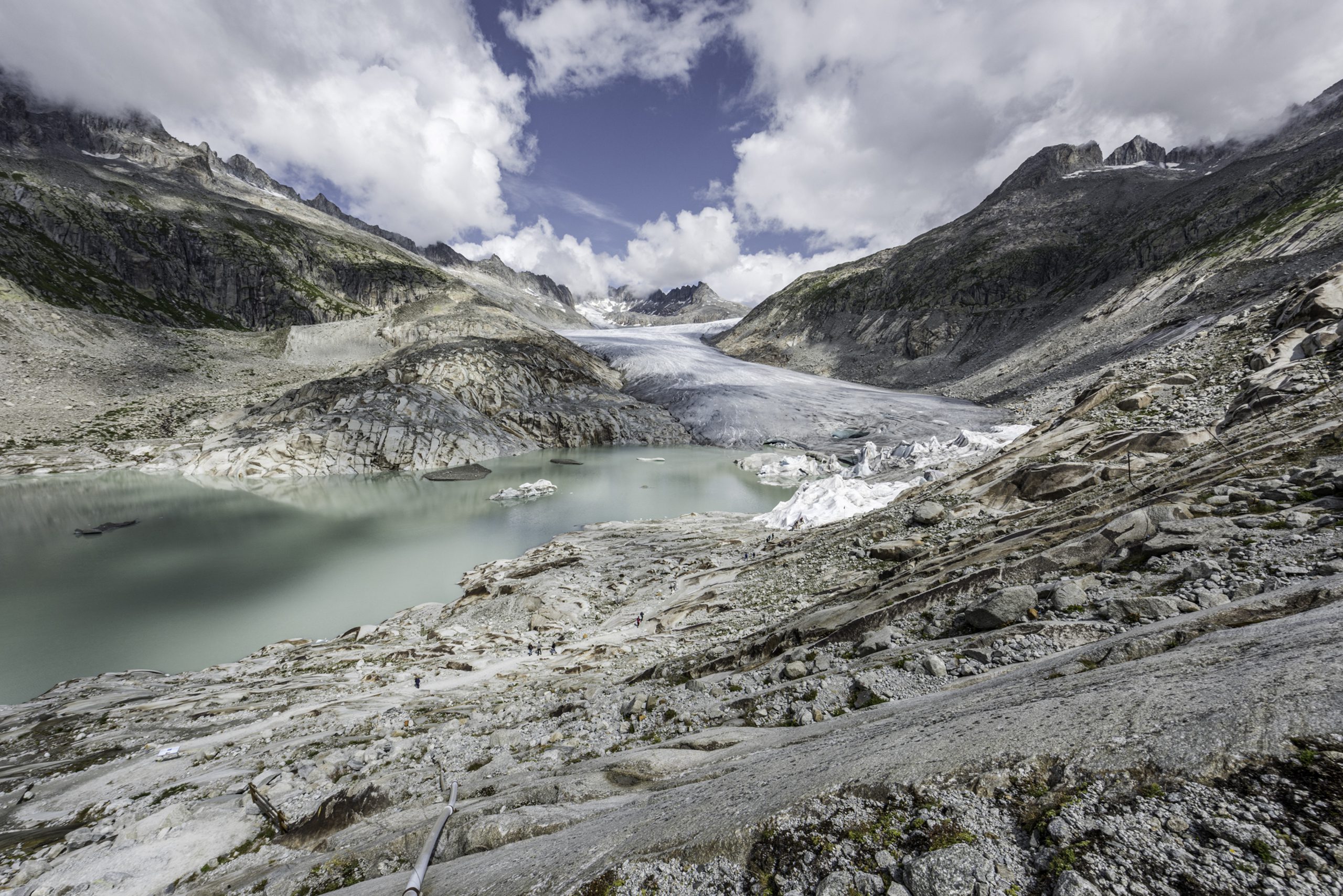
For climatologists, these air bubbles are nothing short of the Holy Grail. In the mid-20th century, scientists suspected that atmospheric CO₂ concentrations had fluctuated significantly throughout our planet’s history. But they’d been unable to establish a robust link between these concentrations and climate change. What they did know, however, was that the tiny air bubbles trapped inside ice were microcosms of the Earth’s atmosphere at different periods. Armed with this knowledge, scientists analyzed the gases contained in these bubbles and their relative concentrations, then compared these findings with average temperature changes, which were inferred from the ice’s isotopic composition.
Antarctic ice sanctuary
The deepest ice cores we now have extend to over 3 km. The oldest ice-core records date back 130,000 years in Greenland and 800,000 years in Antarctica. The clues they hold give us insight into the mechanics of the Earth’s climate and can help us predict its future. But as glacier melting accelerates, this valuable information could be lost forever. That’s why a group of scientists including Jérôme Chappellaz, a paleoclimatologist at EPFL, launched an initiative called Ice Memory to create the world’s first ice core bank and preserve these historical records. Cores that have been drilled in different parts of the world since 2016 will be stored in a specially created sanctuary in Antarctica so that they can be studied by future generations of scientists.
There’s no doubt that global warming will have major societal and economic consequences. According to a study published in Nature Communications in late September, an estimated $143 billion per year of the costs of extreme events can be attributed to climate change. But given the number of interrelated factors at work, it’s not easy for scientists to measure the full cost of climate change or determine how much of this cost is due exclusively to glacier melting. And depending on which global-warming scenario they use, their estimates can vary by a factor of two. However, it’s clear that some industries will be affected more heavily by glacier retreat than others.
Will dams become a thing of the past?
One such industry is hydropower generation – especially in countries like Switzerland where over half of the energy mix (52.8% in 2022) comes from natural water flows. Switzerland’s hydropower plants are fed mainly by rainfall and melting snow, but, more recently, water from lost glacier mass has been making up a growing share. According to a 2018 study by scientists at the University of Lausanne, EPFL’s Laboratory of Hydraulic Constructions and other research institutes, some 3% to 4% of the country’s hydropower, or 1.0 to 1.4 TWh/year, comes directly from glacier mass loss. Their study, appearing in Renewable Energy, provides the first Swiss regional breakdown of the percentage of hydropower originating from glacier retreat. What’s more, it also gives forecasts for how this percentage will change between now and the end of the century. The scientists predict that it will decline substantially by 2040–2060, with a 1.0 TWh/year drop in Swiss hydropower production in the following two decades (2070–2090). The only exception is at hydropower plants along the Rhône, where glacier retreat currently accounts for 6.4% to 8.6% of energy production and the percentage isn’t expected to decline until 2070–2090.
So while we hear a lot of talk about “peak oil,” another tipping point to look out for will be “peak water.” An ETH Zurich study found that peak water has already been reached in half of the world’s 56 large-scale glacier drainage basins. Some of these basins are found in the Peruvian Andes, where hydropower output has fallen by 11% to 15%, or the production equivalent of $740 million/year. Most of Switzerland’s small glaciers have likewise reached peak water. In the future, one way utilities could make up for the lost feed to hydropower plants is to build rainwater-harvesting dams that create reservoirs that serve the same function as today’s glaciers. Scientists have found that up to 683 lakes with a surface area of over 5,000 m² and more than five meters deep could emerge across the Swiss Alps if glaciers were to disappear completely. Additional dams and lakes could be constructed on the beds of disappeared glaciers, which in Switzerland stand to be the Aletsch, Gorner, Grindelwald, Hüfi, Roseg, Trift and Rhône. But at what cost? Such glacier-replacement infrastructure would not only be expensive to operate but would also have a significant environmental impact, since the majority of glacier beds are located in protected environments.
Water cycle under pressure
As glaciers – functionally akin to water towers – melt, that will create major disruption in the water cycle and have severe consequences on mountain communities as well as villages further downstream. In other words, these alterations in the cryosphere will undeniably affect societies and economies, impacting livelihoods, living standards and infrastructure through the critical role that the water cycle plays in farming, livestock breeding, fishing, forestry and the supply of urban drinking water.
Catastrophic forces
Today, few countries are equipped to cope with the kinds of natural disasters – such as floods, debris flow and landsides – that are likely to occur more frequently. Between 1985 and 2014, mountain floods, avalanches and landsides, coupled with other climate-related stresses, caused losses totaling $45 billion in the Hindu Kush Himalayan (HKH) region, $7 billion in the European Alps and $3 billion in the Andes.
Floods caused by glacial lake outbursts are particularly dangerous. They occur when a natural dam containing a glacial lake gives way, instantly releasing vast amounts of water that can submerge entire valleys. This kind of flood occurred in Nepal in 1985 and destroyed a $1.3 million hydropower plant. In India, flooding of the Lhonak glacial lake on Kangchenjunga mountain killed over 70 people in early October and caused damage as far as 120 kilometers downstream. An estimated 15 million people worldwide are at risk of such a disaster, mainly in valleys in the Himalayas (62%), the Andes and the Alps – including 727,000 people in Switzerland – according to a February article in Nature Communications.
Blue, green AND . . . GREY
The picture-postcard image of the Swiss Alps, complete with blue skies, green grass and white glaciers, will become less picture-perfect once the glaciers recede and reveal their grey rocks underneath. The concern here isn’t so much that people will stop buying postcards – this way of staying in touch has been going out of date for a while – but that the iceless landscapes will impact the country’s travel industry. PhD research carried out at EPFL’s Laboratory of Environmental and Urban Economics in 2012 looked specifically at how vulnerable this industry is to global warming. On the one hand, the additional snowfall could increase the number of mountain lakes, making some areas of the country more attractive. And the warmer temperatures might encourage people to venture up to higher altitudes in the summer. But on the other, the thawing permafrost could cause greater soil instability, increasing the chances of a natural disaster – and causing potential tourists to think twice.
And for skiers, glaciers used to be a promise of both an early and late ski season. But that’s changing. Following controversial work on glaciers in both Austria and Switzerland to make them race-ready, this year’s Alpine Ski World Cup got off to a rocky start. The races taking place in Zermatt this fall were scheduled to run two weeks later than in 2022 – that’s because last year’s events had to be canceled owing to warm temperatures. Yet they ended up being scratched this year too, because of heavy snow and high winds. The organizers still raked in many millions of francs in advertising revenue, but how much longer will they believe that 2022 and 2023 were outlier years?
Pandora’s box of pollutants
Glacier melting will affect not just the amount of water on our planet, but also its purity. Glaciers have a variety of chemical compounds locked up amid their frozen water molecules. As the ice thaws, these compounds – which include persistent organic pollutants – will gradually be released. For example, scientists have concluded that the polychlorinated biphenyl (PCB), dichlorodiphenyltrichloroethane (DDT) and other pollutants found in Oberaar lake, in the canton of Bern, in the 1990s came directly from the melting of the Oberaar glacier. Other researchers have warned that glaciers might also contain frozen microorganisms which, if released, could pose a threat to ecosystems and human health.
Another threat comes from the melting of polar permafrost. This permafrost and the surrounding oceans harbor vast amounts of methane – a greenhouse gas that’s 25 times more powerful than CO₂ – which could be released into the atmosphere in fairly short order. This would speed the pace of global warming and its consequences, with developing countries first in line to suffer the effects on farming output, urban development and public health. A study by Prof. Gail Whiteman at the Rotterdam School of Management estimated that the release of methane trapped in the Arctic could cost the global economy $60 trillion – and that calculation was made back in 2012.
A flooded world
If all mountain glaciers around the world melted, that would raise sea levels by only a few centimeters. The real problem lies in the disappearing Antarctic. The melting of this ice cap would lift sea levels by some 60 m, submerging many large cities – such as Paris, London and Berlin – in the process. Of course, it would take several centuries for the Antarctic to fully disappear, contrary to Hollywood portrayals. But the process could go much faster in the Arctic. The Northern Sea Route – a shipping route that cuts across Arctic waters to connect Europe and Asia – is free of ice for longer periods each year. It cuts the shipping distance between the two continents by 7,000 km (shortening it from 22,000 km to 15,000 km). Having these waters navigable for longer is boosting demand for the region’s fishing and natural gas resources – but is that really good news?
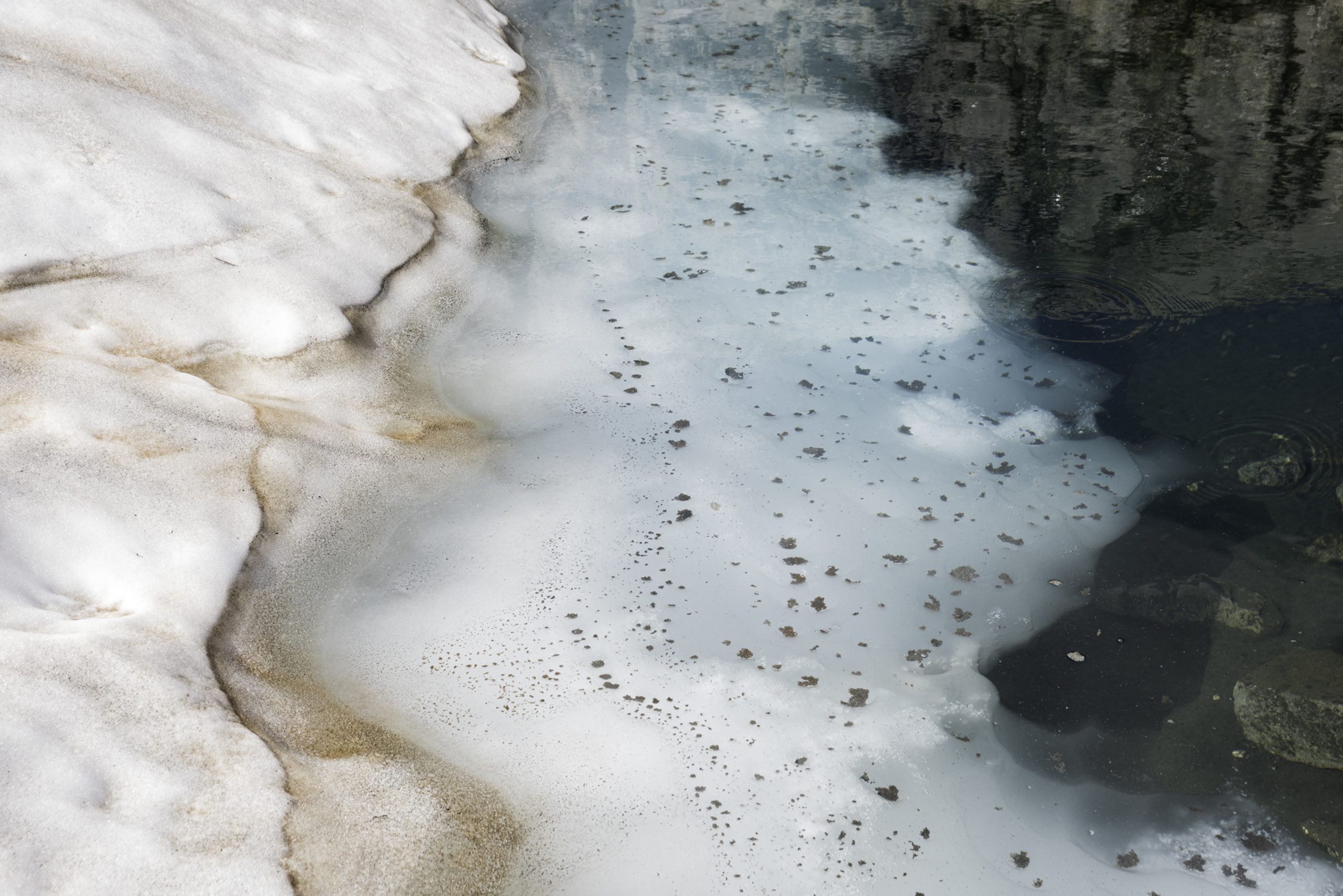
ALPOLE, the Alpine and Polar Environment Research Center
Located in Sion at the heart of the EPFL Valais Wallis campus, ALPOLE aims to become an international center of excellence in the science and engineering of the Alpine and polar environment. The research carried out focuses on the study of climate change at high altitudes and latitudes, which are sentinels of climate change, as they struggle to cope with rapid change and unprecedented transformations. These issues are particularly relevant in the current context.
The cascading effects of global, regional, and local relevance go beyond nature-related aspects, affecting built environments such as agriculture, tourism, infrastructure planning and landscape management.
A major challenge is, and will continue to be, understanding and predicting climate-induced impacts on the environment, as well as adapting to these impacts. The Valais Alps constitute one such ecosystem, and are an ideal testing ground for environmental scientists and engineers.
Inaugurated a year ago, the ALPOLE building houses eight EPFL research chairs — most of which have been newly created – for a total of 150–180 highly qualified scientists. Through a variety of research and teaching programs, ALPOLE provides support to the work being done at the Swiss Polar Institute. ALPOLE also accommodates some researchers from EPFL’s Interdisciplinary Centre for Electron Microscopy and the EPFL Valais-Wallis operations management team.
Addressing global warming will require politics, industry and academia to develop new, innovative ways of working together, says Jérôme Chappellaz, head of the Ferring Pharmaceuticals Margaretha Kamprad Chair in Environmental Sciences at EPFL. The academic director of EPFL’s Alpine and Polar Environmental Research Centre (ALPOLE) in Sion, regards the canton of Valais as an ideal laboratory to study impacts of and solutions to address our shrinking Alpine glaciers. We spoke with Chappellaz about his concerns and hopes for the future, both in Switzerland and around the world.
Jérome Chappellaz, will there still be ice in Switzerland in 2100?
It depends on how much greenhouse gases we emit into the atmosphere. If we stabilize our emissions and limit warming to the 1.5-degree target set at the COP21 climate conference, then only half of our glaciers will disappear. If we keep emitting 40 billion tons of CO₂ per year, many mountain ranges, including the Alps, will be ice-free. From now until 2100 is a micro-slice of history. What we emit into the atmosphere today will remain for a long time. The climate system is relatively sluggish – the glaciers in Greenland and Antarctica haven’t yet caught up with our current atmosphere. These systems are slow and can take decades, centuries, even millennia to respond.
What would be the concrete impact of a snow- and ice-free Switzerland?
Most obviously there are anecdotal impacts: We are used to Alpine landscapes covered in snow and ice. It’s hard to imagine our valleys without dominant glaciers. Then there are the practical consequences: our glacial water stores will no longer be available to feed human activities like agriculture in spring and summer.

Jérôme Chappellaz. Illustration by Laurence Piaget-Dubuis
Couldn’t we simply build more dams?
We could, but we may already have reached a limit in terms of suitable valleys. Remember: the changing climate isn’t just affecting the cryosphere; it’s also changing rainfall patterns. In western Switzerland, we’re likely to see a decrease in summer precipitation, more extreme rainfall events and longer, more intense droughts.
Would you say it’s too late for us to reverse course, then?
2023 could be the first year in which global average temperatures reach 1.5°C above pre-industrial levels. Granted, this would just be a single year, not a multi-year average. But we are talking about a target set for 2100! Our greenhouse gas emissions are not decreasing enough. Even during COVID-19, global CO₂ emissions dropped by less than 5% – despite severe economic slowdowns and travel limitations. That should put things into perspective.
That makes it difficult to have an optimistic outlook.
If the earth was the Titanic and the citizens of our planet were the passengers, we scientists would be the lookouts who notice the approaching iceberg. As long as the captains – our governments, and affluent economic players – continue to debate who is the most powerful and what music should play in the ballroom, there’s no reason for us not to hit the iceberg.
When we feel powerless, we convince ourselves that the problem is not as bad as it sounds. It’s a survival instinct.”
How do we know for sure that humans are to blame for the observed warming?
The science behind the greenhouse effect is well known. The first person to anticipate its existence, in 1824, was Joseph Fourier, the famous French mathematician. In 1861, John Tyndall of Ireland measured the absorption of infrared energy by water vapor and CO₂. Then, in 1896, Svante Arrhenius of Sweden calculated surface temperature changes for a doubling of atmospheric CO₂ concentration, predicting a 3-degree temperature rise.
That relation still holds true today.
Yes, but that isn’t to say that we know everything. Like, how is the excess heat that stays on Earth transformed, and at what speed? Glaciers in Antarctica and Greenland are losing mass, but we still don’t know just how much and when tipping points might be reached. If the floating glacier tongues rupture, we could see a major increase in sea level. The melting of the Antarctic glaciers at Pine Island and the Twaites “doomsday” glacier could raise the sea level by 15 meters.
What do you say to those that argue that the climate has always been changing?
That misses the point. The question should be: at what speed and magnitude is warming taking place? And what capacity does humanity have to adapt? In this century, the temperature could change by up to 5°C. The last comparable natural major heating event started 20,000 years ago and took 10,000 years to unfold. Back then, we lived in small mobile tribes who could move to better environments. Today, where can we go?
In your expeditions, you’ve seen major transformations at the poles. Can you give us examples?
In Antarctica, the biggest change has been the heat. The French Antarctic station at –67 degrees southern latitude had rain in 2014, 2017 and last year. When it rains on baby penguins, whose fur is not waterproof, they freeze to death. And at the German-French polar station in Svalbard, researchers used to cross the fjord on a skidoo in winter. Today this is no longer possible because the fjord no longer freezes. We’ve seen North Atlantic fish species compete with the Arctic ones. This is impacting indigenous human populations too.
What types of solutions are out there?
Reduce greenhouse gas emissions! Geoengineering, for example, might also generate solutions by directly reducing atmospheric CO₂ levels. At EPFL, researchers are currently working on solutions at the laboratory scale. But even when there is a scientific breakthrough, it can take decades to scale up solutions for real-world deployment. So far, we have not found a miracle solution.
The evidence is overwhelming, and yet polls suggest that climate skepticism is on the rise. Why?
In my view, it comes back to our natural reflex of denial. When we feel powerless, we convince ourselves that the problem is not as bad as it sounds. It’s a survival instinct. It would be interesting to have social scientists analyze the past four decades since the first IPCC report was published in 1990. This first report stated that it was highly probable humans were causing global warming. Today it’s a certainty. Still, some, including industry groups with major economic influence, continue to argue that the science is not yet settled. This casts doubt on the scientific findings.
I feel like we need to focus on intergenerational responsibility. How will people tomorrow judge their parents’ and grandparents’ actions?”
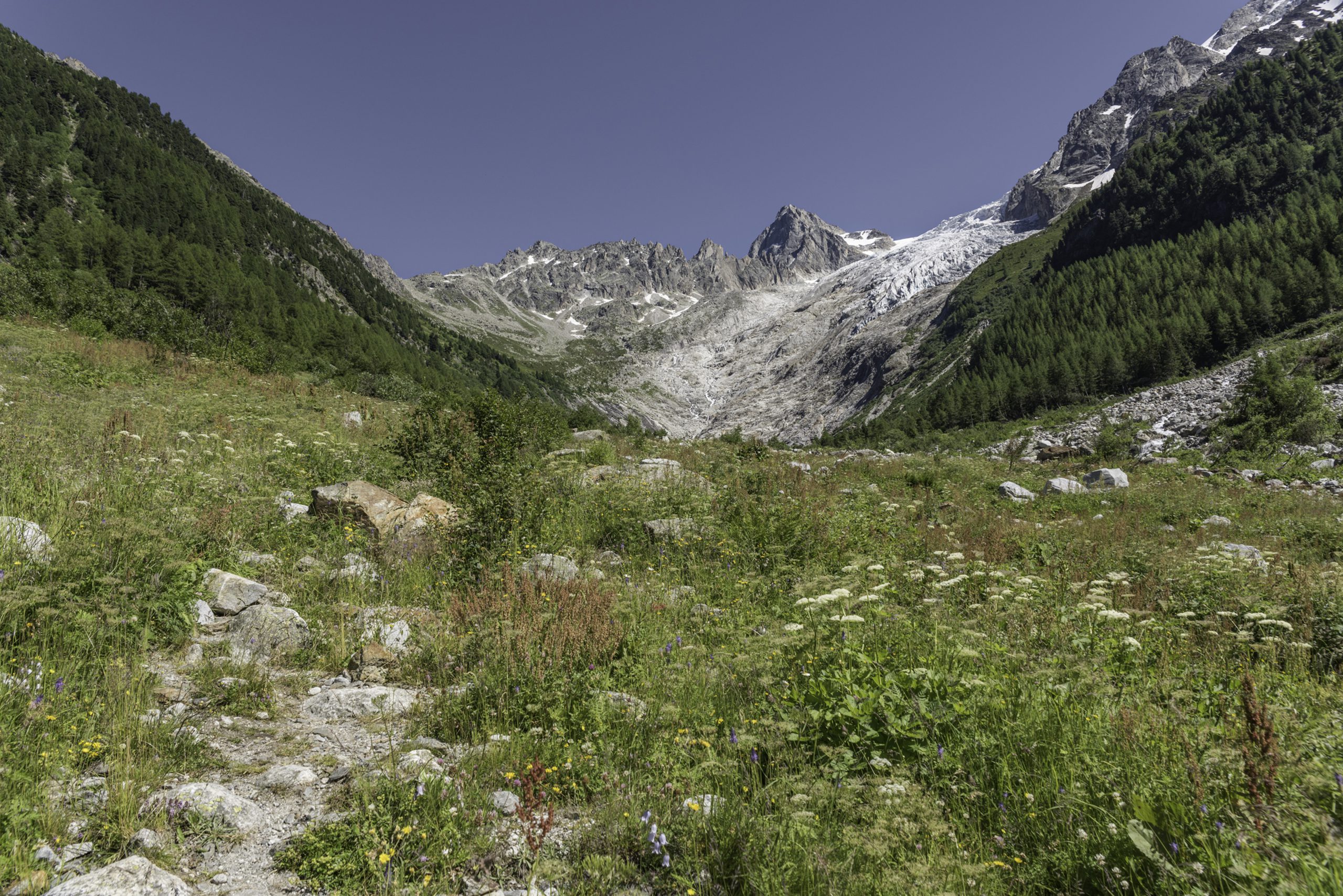
What would be a sane way to deal with the situation?
Most people understand the situation but feel powerless. Sure, they could retreat into a cave and live as hermits, but even that wouldn’t make a difference. So, should we pull out the vodka and dance our final dance? Of course not. I feel like we need to focus on intergenerational responsibility. How will people tomorrow judge their parents’ and grandparents’ actions?
You are the academic director of ALPOLE, EPFL’s Alpine and Polar Environmental Research Center. What role do you see the center playing?
ALPOLE’s expertise spans physics, chemistry and biology from high-altitude Alpine phenomena to polar regions. This diversity lets us build bridges between the relevant disciplines. Additionally, with the canton of Valais, we have an ideal experimental playground.
The challenge is to motivate researchers in fundamental sciences to contribute to practical solutions. We need to create a local laboratory of sorts to test ideas with businesses, energy producers and politicians that benefit the local community. The canton of Valais seems motivated to evolve beyond skiing, tourism and wine to spearhead scientific innovation in adapting to the changing climate.
Assuming we succeed in finding a way to manage the challenges that lie ahead, where do you see the seeds of that solution today?
We can see some of it in our universities. Students are making it clear that they don’t just want to be excellent engineers who are good at math and robotics but also seek meaning in their professional lives that rests on planetary challenges. For them, businesses that make millions while negatively impacting water, natural resources and social peace are no longer acceptable. Here, schools like EPFL need to take charge. We’re walking a tightrope. As we train engineers to develop the technologies of the future, we also need to cultivate responsibility in our future scientists. The two are not incompatible.
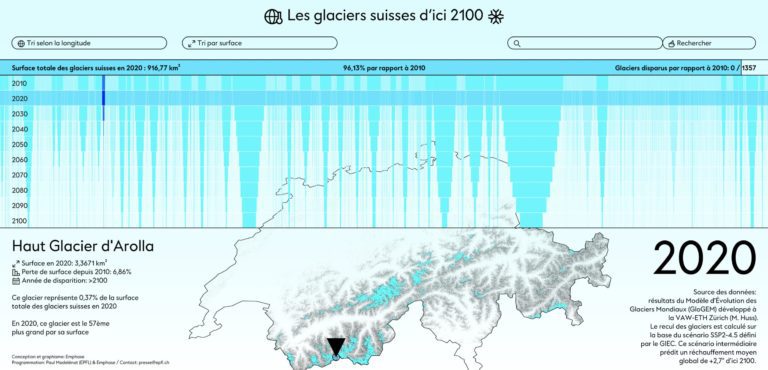
Ten percent: that’s the amount of volume lost by Swiss glaciers in the past two years. Scientific models predict continued rapid melting in the coming decades unless climate measures are adopted. Find out, through our animated infographic, what Swiss glaciers might look like by 2100.
© 2024 EPFL / Emphase
I’m lucky to have seen several glaciers up close over the past 50 years, to have walked on some of them with my camera and backpack, and to have witnessed firsthand the incredible beauty that’s now under threat. I’ve been amazed by the vast blue expanse and the sublime way in which water cycles between its solid, liquid and vapor forms. The mountains are a boundless source of inspiration. Throughout my life, I’ve been marked by the silence, the flora and fauna, the untouched wilderness, the clean air and the stunning landscapes here in Switzerland. I’ve also seen how greedy humans can be in mercilessly exploiting the Earth’s resources, and how inept we’ve been at embarking on the kind of swift, intelligent transition that’s essential for us to meet future challenges and ensure our very survival.
